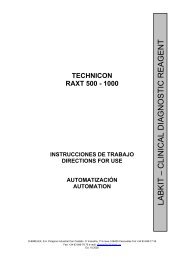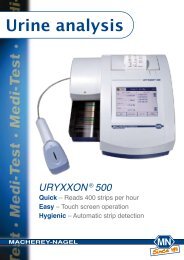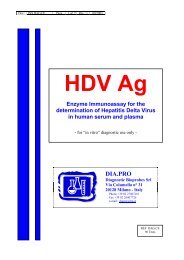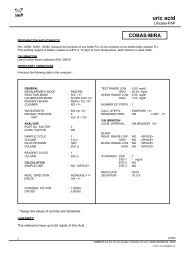[SAS-1 urine analysis]. - Agentúra Harmony vos
[SAS-1 urine analysis]. - Agentúra Harmony vos
[SAS-1 urine analysis]. - Agentúra Harmony vos
- No tags were found...
You also want an ePaper? Increase the reach of your titles
YUMPU automatically turns print PDFs into web optimized ePapers that Google loves.
<strong>SAS</strong>-1 URINE ANALYSISVisual interpretation of bands present on the gel by immunofixation:Type of Proteinuria Bands Observed On Gel Proteins PresentNormal <strong>urine</strong> Small albumin band albuminGlomerular Albumin, alpha-1, albumin, alpha-1beta, gammaantitrypsin, transferrin,gamma globulinsTubular alpha-1, alpha-2, beta Retinol Binding Protein,beta2-microglobulin,alpha-2 microglobulinOverflow gamma or variable immunoglobulins,free light chainsLIMITATIONS1. Antigen ExcessAntigen excess will occur if there is not a slight antibody excess or antigen/antibody equivalence atthe site of precipitation. Antigen excess in IFE is usually due to an excess of the immunoglobulinin the patient sample. Antigen excess is characterised by prozoning (unstained areas in the centreof the immunofixed protein band, with staining around the edges). A higher dilution of the sampleshould be used in this event to optimise the immunoglobulin concentration.2. Band In Cathodic End of Gamma Region Showing No Reactivity With IFE Antisera.C Reactive Protein (CRP) may be detected in patients with acute inflammatory response 6,7 .CRP appears as a narrow band at the cathodic end of the serum protein pattern. Elevated Alpha1-Antitrypsin and Haptoglobin are supportive evidence for CRP. Patients with a CRP band willprobably have an elevated level when assayed for CRP.3. Non-Reactivity With Kappa and Lambda AntiseraOccasionally a sample will have a reaction with a heavy chain antiserum but no light chain reactionis obvious. In this situation, the following need to be ruled out - a) Heavy chain disease, b) Veryhigh concentrations of light chains, leading to antigen excess, c) Low concentrations of light chains,d) Atypical light chain molecule that does not react with the antiserum, e) Light Chains with‘hidden’ light chain determinants (as sometimes seen with IgA and IgD). To obtain definitiveresults, testing may include a) A higher or lower dilution of the sample to optimise theantibody/antigen equivalence, b) Antisera from more than one manufacturer to aid in theidentification of atypical immunoglobulins, and c) Treat the sample with b-2-mercaptoethanol to‘reveal’ the light chains.7English


![[SAS-1 urine analysis]. - Agentúra Harmony vos](https://img.yumpu.com/47529787/9/500x640/sas-1-urine-analysis-agentara-harmony-vos.jpg)
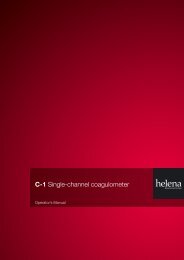
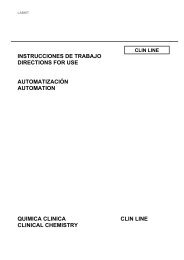
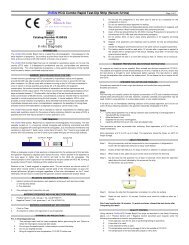
![[APTT-SiL Plus]. - Agentúra Harmony vos](https://img.yumpu.com/50471461/1/184x260/aptt-sil-plus-agentara-harmony-vos.jpg?quality=85)




![[SAS-MX Acid Hb]. - Agentúra Harmony vos](https://img.yumpu.com/46129828/1/185x260/sas-mx-acid-hb-agentara-harmony-vos.jpg?quality=85)

